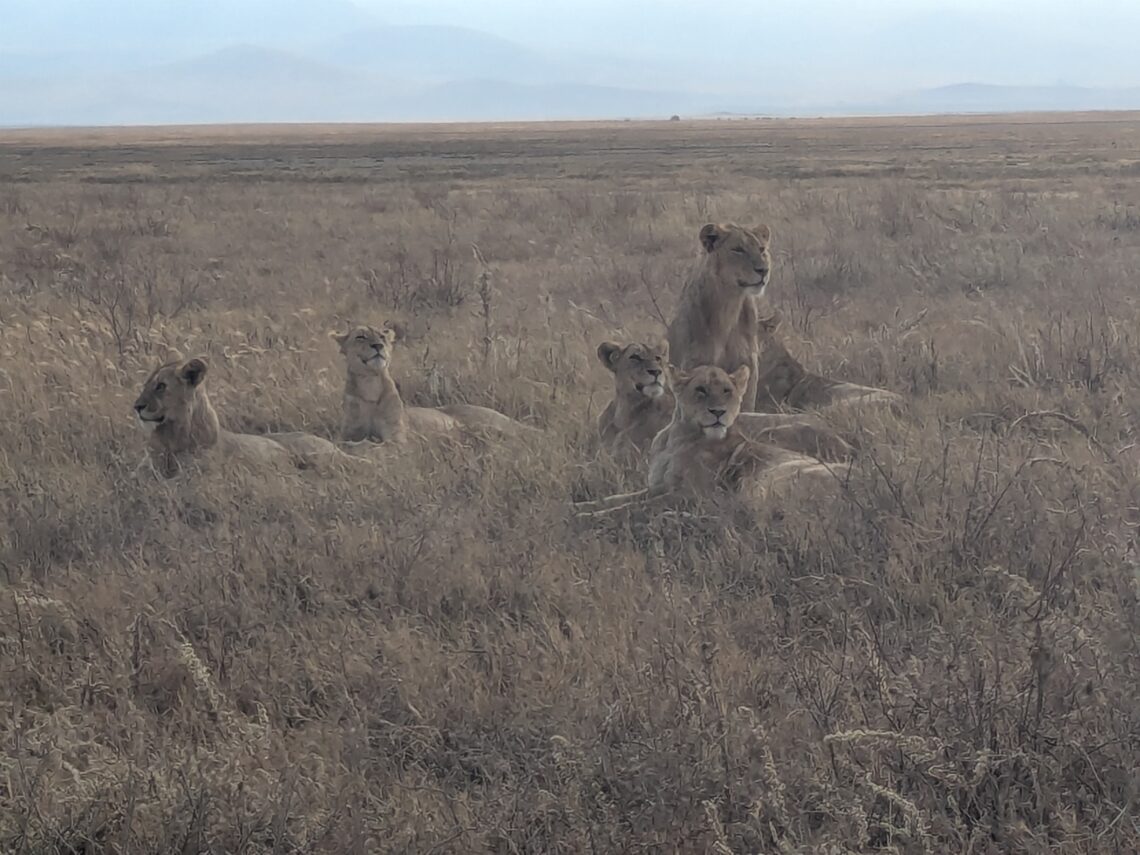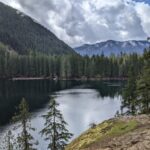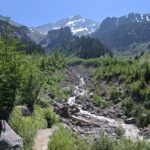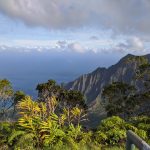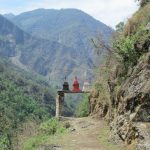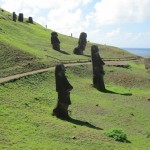Jambo from Tanzania!
After about 40 hours of travel, we landed at Kilimanjaro Airport in Tanzania on September 3. We arrived at our hotel in Arusha, took some well-deserved naps, and did basically nothing on day one.
On day two, we went on an excursion to a hot spring that was lovely but much farther away than we realized—five hours round trip on slow, bumpy roads. This is Africa.
On day three we headed out for a five-day safari with Suricata Safaris, so the rest of this post will focus on that adventure.

Day 1 – Tarangire
Our safari guide, Shivani, picked us up at our hotel in Arusha. We were in a safari jeep with four other people—a couple from Spain and two sisters from France. The drive to Tarangire National Park took about two and a half hours. Along the way, Shivani told us about some of the crops grown in Tanzania (coffee, bananas, rice, papaya, etc.) and pointed out towns we passed. We even spotted some baboons along the road.
Once inside Tarangire, we opened the roof of our safari jeep and started spotting wildlife right away. Giraffes, wildebeest, zebras, and eland—the largest species of antelope in Tanzania—welcomed us.
At a picnic area, while we were enjoying lunch of rice, chicken, and veggies in curry sauce, a mob of mongoose suddenly popped out behind our table and dashed across the grounds.
The afternoon brought even more sightings: elephants, warthogs by a watering hole, baboons coming down to drink, and antelope mingling alongside them. We got up close with a family of elephants, saw giraffes gracefully moving through the trees, and admired large herds of zebras and wildebeest (who often hang out together). As we left the park, we spotted a lioness resting in a tree in the distance.
That night we stayed at Suricata Boma Lodge on Lake Manyara (Rich and I and the Spanish couple selected the lodge option while the French sisters were at a campground nearby). The lodge felt quite fancy—concrete cabins with lake views, a pool with a bar, and even a spa and fitness center. We enjoyed cocktails by the pool and an acrobatics show performed by some of the staff. Then we had a buffet dinner and were off to bed to rest up for day two.

Day 2 – Lake Manyara
After breakfast, Shivani picked us up at the lodge, we swung by the campsite to pick up Chloe and Sarah, the French sisters, and headed into Lake Manyara National Park. The park is famous for tree-climbing lions, but, sadly, none were visible that day. The animals we did see more than made up for it.
First up were blue monkeys, followed by a true African traffic jam—a herd of elephants blocking the road and bringing safari jeeps to a standstill. We saw tons (literally, many tons) of elephants in Lake Manyara, some so close they walked right next to our jeep.
There were also hundreds of baboons, including a massive troop moving along the lakeshore that we stopped to watch for a while. Antelope grazed nearby, and birdlife was abundant: hornbills, herons, pelicans, and storks. We spotted hippos in the distance before leaving the park.
Back at Suricata Boma, we spent some time at the pool before another delicious buffet dinner.

Day 3 – Serengeti
It was a long, bumpy drive through Ngorongoro Conservation Area to reach the Serengeti—over three hours on unpaved roads, nicknamed the “African massage” by safari guides. We stopped at a viewpoint overlooking Ngorongoro Crater, which isn’t actually a crater but the world’s sixth-largest caldera (four of the top five are in Japan).
The animals roam freely between the park boundaries, so we saw giraffes and elephants during the drive. After lunch just outside the Serengeti gate, we opened the roof for our afternoon game drive.
The Serengeti quickly lived up to its reputation. Within minutes we saw lions in the distance. Shivani hurried us onward, and we soon understood why: three male cheetahs were lounging in the grass and our jeep stopped just a few feet from them. They got up and walked around as the jeeps came close which allowed us some terrific photo opportunities.
Soon after we left the cheetahs, we stopped to watch lionesses with cubs napping on rocks, then drove to see more lions—two males dozing while another group of females and cubs relaxed nearby. It was a big-cat cornucopia!

As the day ended, we spotted more elephants and antelope, but the cats were definitely the highlight. We watched the sun set over the Serengeti on our way to Serengeti Bush Camp, our accommodation for the night.
Our “rooms” at the camp were large canvas tents with king-sized beds and full bathrooms. After dark, an escort was required to walk between tents and the dining or bar areas since wild animals roam through camp.
That night coincided with the “blood moon” total lunar eclipse. The moon was already a quarter covered when we walked to dinner, and by the time we returned to our tent the full eclipse glowed a deep red in the sky. I stepped outside every 20 minutes to watch the eclipse through its phases. Gorgeous!

Day 4 – Serengeti to Ngorongoro
The Spanish couple in our group did a hot air balloon ride at sunrise over the Serengeti (their photos looked amazing). While they saw the park from above, Rich and I joined four other travelers with a different guide, Amani, for a morning game drive.
Almost immediately we saw hyenas, giraffes, and elephants. Then came the real thrill: Amani took us to see a leopard resting beneath a tree. Too far for photos, but still an unforgettable sight!

Later we met up again with Shivani and the rest of our group. At a watering hole we saw crocodiles and hippos cooling off, and the drive back to the park entrance offered sightings of eagles, buffalo, giraffes, ostriches, and another leopard, although this one was also too far away for photos.
That night we stayed at Ngorongoro Tortilis Camp, set in a lush forest with luxury tents and the same after-dark escort system. We gathered by the firepit with fellow travelers—sharing beers and stories before dinner.

Day 5 – Ngorongoro Crater
At nearly 8,000 feet, the crater rim was chilly in the morning. After a hearty breakfast buffet, Shivani drove us down the steep road into the caldera.
Shortly after we reached the bottom of the road, we watched a pride of lions—two young males and several females—lazing in the grass. Later, we drove through the grazing herds of wildebeest, zebra, and buffalo before reaching a lake filled with hippos and flamingos.
During a leg-stretch break, we walked around with guinea fowl, a very large marabou stork, and a bloat of hippos. There were plenty of warning signs not to get close to the hippos- they kill more people each year than lions. We drove to the far side of the caldera, seeing a few more herds and antelope along the way, before climbing back up the rim. After lunch at the crater’s edge, we returned to Arusha, our safari complete.

A Few Notes About the Safari
- The roads: Most are unpaved and bumpy. If you get carsick, bring Dramamine and try to sit up front.
- Accommodation levels: You can choose from camping, lodges, or luxury.
- Camping is basic- large tents with mattresses, sleeping bags, and pillows. Shared bathrooms are nearby. Some camps have pools, and meals are in dining tents. Wildlife often wanders through camps, which can be loud but exciting. Guides caution you to keep your distance from elephants and hyenas, though zebras will happily graze nearby.
- Lodges, which is what we selected, are marketed as “mid-range,” but they felt high-end to me. Comfortable rooms, great buffets for breakfast and dinner, and very friendly staff. Alcohol costs extra, but everything else was included.
- We didn’t see any of the luxury lodges but I imagine they are impressive based on how upscale the lodges were.
- Crowds: You won’t have solitude. These parks are popular, and many safari companies operate on the same standard itineraries. Guides use radios to share animal locations, so there are often many vans surrounding the more popular sightings and patience is sometimes required to get a clear view.
- Tipping: Wages in Tanzania are low compared to the U.S. and Europe, so tips are important and appreciated. Each lodge has a tip box for staff, and tipping your guide is expected. Guides usually share tips with their support crew. As of 2025, $15 per day per person was the standard tip for the guide/support crew.
- Binoculars: Essential! You’ll get close to many animals, but some (like leopards) may only be visible at a distance. Without binoculars, you’ll miss out.
